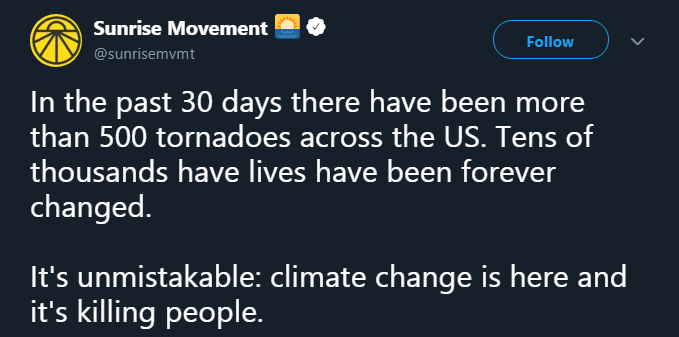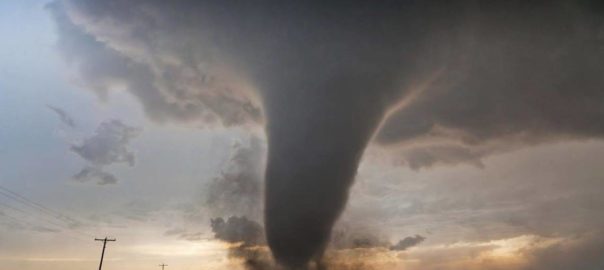By Kent R. Kroeger (Source: NuQum.com; June 28, 2019)
Tornadoes have been a fascination of mine since my childhood. Growing up in Iowa, in ‘Tornado Alley,’ one of my earliest memories is that piercing warning sound our local TV station, WMT-TV (now KGAN), would broadcast when a tornado warning had been issued in the area. Meteorologist Conrad Johnson’s deep voice would boom over a live, black-and-white weather radar image, its round shape like a vintage Tektronics oscilloscope, and something very few local TV stations had available in the late 1960s. Just white blobs on a dark background. White is rain. Black is not rain.
Johnson, a tall, almost father-like figure to anyone growing up in Eastern Iowa in the 60s and 70s, was a national pioneer of broadcast meteorology. When few local TV stations had their own weather radar systems (I have yet to find one earlier than WMT-TVs), Johnson personally re-purposed a military radar system for use by the Cedar Rapids, Iowa-based TV station. I was no more than five years old when I first learned how a hook shape in a storm’s radar image could indicate an active tornado. For me, Johnson made tornadoes exciting, even as they were terrifying.
Johnson also led the national effort to build the National Weather Service tornado watch/warning system which has since saved, conservatively, thousands of lives. This YouTube video is a reminder to me that things low-tech by today’s standards didn’t mean we were getting less information. Quite the opposite, Johnson made us all smarter:
After tornadoes had struck our area, Johnson considered it his job to explain what happened and how we might be able to prepare better for future storms.
“On the synoptic situation that preceded the tornado which struck Cedar Rapids on early Wednesday morning, we go back and reconstruct a little bit,” started Johnson’s on-air class on tornadoes. (I still don’t know what ‘synoptic’ means.)
When I watch TV meteorologists today, Johnson is still my gold standard. He was more scientist than polished media personality. His words carried weight.
I thought this essay was about trends in tornadoes. Why do I reminisce about this now?
The simple answer is, I think today’s meteorologists and climate scientists get a shitty rap from climate change skeptics (a group that I have some sympathies with when they challenge climate change activists for their ‘sky-is-falling’ rhetoric). I hate hyperbole, always have, and Conrad Johnson was everything but hyperbole and he was far more effective at education for that reason.
But today’s social media-driven political dialogues reward the exact opposite behavior. Here is a recent tweet from the Sunrise Movement, a climate change activist organization.

It is an eye-catching statement to make. I have no doubt it motivates the true believers. But they are jumping way ahead of the science. And don’t take my word for it. Listen to the one of the scientists most knowledgeable about the issue, Northern Illinois Professor Dr. Victor Gensini:
“No, climate change did not cause the recent rash of US tornadoes. Climate change does not cause any given extreme weather event. It does alter background probabilities of the PDF curve.
Most of the literature has focused on severe convective storms in the aggregate sense due to the lack of a good discriminator among hazards using regional climate models….These studies suggest that severe weather environments and surrogate severe will increase in the spring and become more variable from year to year. This is not (yet) specific to any specific severe convective system.”
That is statistician-speak for: low-probability, extreme events are hard to explain and predict using highly aggregated predictors.
In layman’s speak: you can’t say a baseball player uses steroids because he hit a lot of home runs last week.
It may be decades before scientists can show a statistically-significant link between global warming and tornadoes.
I end this essay with the most recent data from the National Oceanic and Atmospheric Administration (NOAA) on U.S. tornadoes. Figure 1 shows the frequency counts by year, and Figure 2 shows the average number of tornadoes per daily outbreak.
Figure 1: U.S. Tornado Annual Frequencies from 1954 to 2019*

Figure 2: Average Number of EF3 or Higher Tornadoes per Daily Outbreak

Figure 1 indicate no discernible trend in annual tornado frequencies (EF1 or higher) since 1954. You can’t even squint a trend from that data series. Figure 2, however, does suggest a small increase in the frequency of large tornado outbreaks (EF3 or higher). But the trend signal is still too hard to distinguish from normal year-to-year noise.
It is too easy to exaggerate the significance of extreme, isolated events in today’s highly politicized media environment. Perhaps my own childhood memories have exaggerated the wisdom of my favorite TV meteorologist, but I believe he’d be cautioning us today about exaggerating the link between tornadoes and climate change.
- K.R.K.
